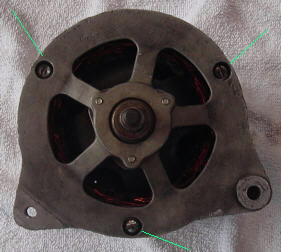
The E-Type alternator (Lucas 11AC) and associated control circuitry seem to be surrounded in mystery. In this article, the design of the alternator circuit will be explained in detail, with some trouble shooting tips.

First, we will discuss how an alternator works. To condense six months of physics into one easy sentence is difficult, but here is: an electric current is induced in a wire if it's exposed to a variable magnetic field. In principle, it's that simple.
In the case of an alternator, the wire consists of three coils mounted around the inside of the case, these are collectively referred to as the stator. The magnetic field comes in the form of a field coil wound around the shaft: this assembly is referred to as the rotor. When the field coil is powered, it becomes an electromagnet. If the the rotor is then turned, the magnetic field moves across the stator coils, and induces a current.
As the field coil rotates, any given point on the stator is exposed first to the north pole of the electromagnet, then to the south. As a result, the induced current is AC: it alternates from positive to negative. To make this current useful to your car's electrical system, it must be converted to Direct Current (DC). This is accomplished with the diode array. A diode is a simple semiconductor which allows electricity to pass in one direction only. There are six diodes. The reason for six is that there are three field coils: each coil has a positive and a negative diode.
One of the problems with any alternator is how to get current to the electromagnetic field coil. This is accomplished with two copper contacts, called slip rings. On a Lucas alternator, these are located on the back of the field coil. Power reaches them through two carbon contacts, which are mounted in a plastic support on the rear of the alternator case.
Let's take a closer look. Here's a diagram of the stator and diodes:
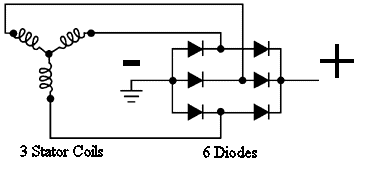
The three stator coils are tied together at one end. This style of alternator wiring is called a "wye" or "star", for obvious reasons. It has the advantage of producing relatively high voltage at low RPM's, one of the key reasons to use an alternator. Note that there is a pair of diodes for each stator coil. But this is a little confusing: in fact, at any given time, power is flowing through more than one coil. You can visualize it like this:
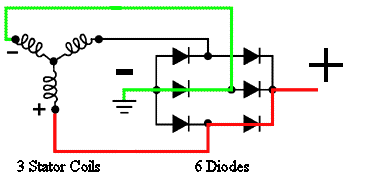
As the rotor is turned, the magnetic field alternately induces positive and negative currents in the various stator coils: at any given time, a coil might be oriented with negative or positive current flow. Because of the way the three coils are set in the case, they are "out of phase", meaning as one coil becomes more negative, it's companions are becoming more positive. It's the job of the diode array to make DC of this, by directing the varying flows in the right direction. Now let's look at the Field Coil (rotor) circuit:
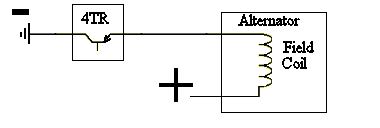
To review, the field coil is a rotating electromagnet. Power to the field coil comes from the positive post of the battery via the slip ring. But if all available current was fed to the field coil, the alternator would generate too much output voltage. It's the job of the 4TR voltage regulator to keep the alternator "under control". The way it does this is to constantly sense the alternator's output, and cut the field coil's connection to ground when the output rises too far. When the output drops back in range, the 4TR reconnects ground. This happens hundreds of times every minute, and regulates output to around 14.3 volts.
There's one more circuit we need to look at:
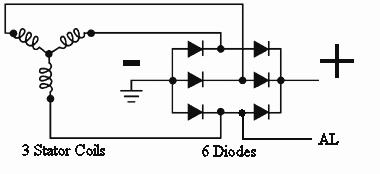
In this diagram, we've added an output lead labeled "AL". This is the alternator sense lead. It's picking up AC current directly from the stator. The purpose of this is to provide a way of sensing whether the alternator is in good health: if the power flowing through the stator fails, we can tell, because the pure AC isn't mingled with battery current. As we will see, this lead is what causes the warning light on your dashboard to light up. Ok, let's put the whole thing together (click here).
Copyright © 2003 CoolCat Express Corp. All Rights Reserved.